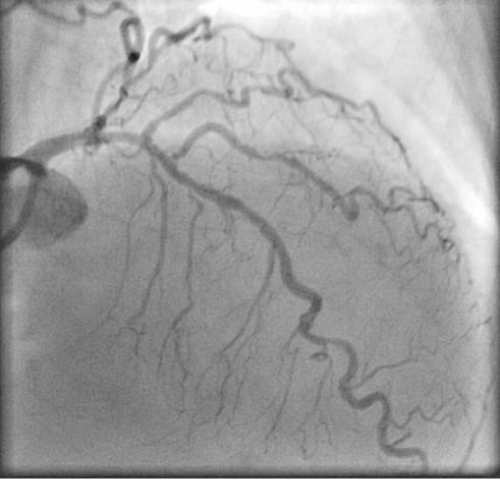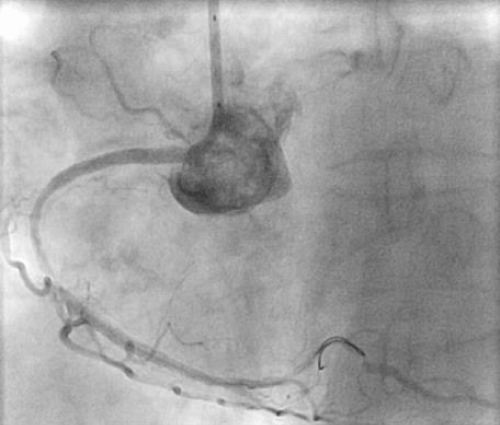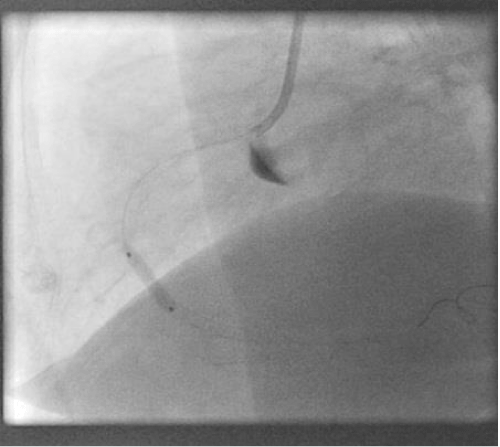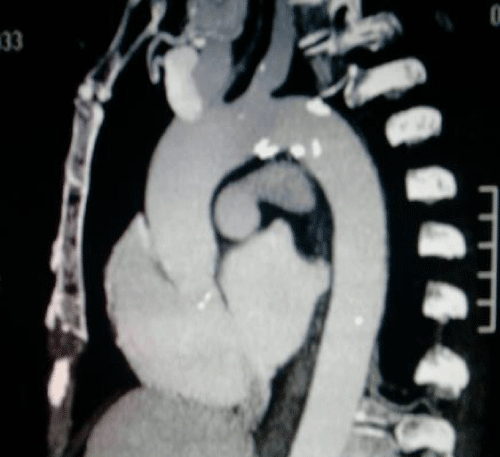Journal of Cardiovascular Medicine and Cardiology
Sinus Valsalva Dissection with Involvement Right Ostium Artery during PCI Rescue: A Rare Complication
Scianna Salvatore*
Cite this as
Salvatore S (2018) Sinus Valsalva Dissection with Involvement Right Ostium Artery during PCI Rescue: A Rare Complication. J Cardiovasc Med Cardiol 5(2): 018-019. DOI: 10.17352/2455-2976.000064Introduction
Aorto-coronary dissection is a rare complication that occur during percutaneous coronary intervention, but life threatening. We describe a case of limited iatrogenic dissection of Valsalvae, with ostium right coronary artery, during a PCI rescue perfomed via trans-radial approach and was successfully treated without surgical intervention.
Background
A women of sixty-five years old, with hypertension and diabetes mellitus, doesn’t presented others coronary risk factors. Her height was 165cm and body weight 77 kg. Was ammited in Accident and Emergency department for effort angina, dyspnea.
Was performed ECG and showed: ST elevation on inferior leads and ST depression on lateral leads with incomplete right bundle branch. Blood chemistry tests revealed the elevation of cardiac enzymes troponine T (value: 0,894 ng\mg), Creatine Kinase Muscle/ Brain (value: 89,3 ng\mg). She was diagnosed with acute inferior-posterior myocardial infarction and underwent emergency coronary angiography. We have cannulated right via radial approach left coronary artery with diagnostic catheter Tiger 6Fr without complication (Figures 1,2), after we performed easily Right coronary angiography with a soft tipped 6-French JR4 guiding catheter (USA) having a 0.064 inch inner diameter. Than we perfomed PCI, with direct stenting on culprit lesion until we recognized on fluoroscopy localized on right coronary cusp staining by the contrast medium (Figures 3-5).
So we performed immediately to the stenting of the ostium with limitation of the right coronary to limit the dissection to the right sinus valsalvae, followed by multiple stent implantation on the I II III tract of the right coronary artery. Because of lack of chest pain and of signs of ischemia on the electrocardiogram we’ve perfomed, after percutaneous coronary intervention, a trans thoracic echocardiography demonstrating absence of pericardial effusion or aortic regurgitation. The procedure was concluded without other complication and the patient was sent to the coronary care unit for further monitoring. We have performed a urgent Heart Computer Tomography (Figure 6) that revealed absence of aortic root dissection. With routine treatment including beta-blockade and low molecule weight heparin 6000 U.I., the patient remained in the hospital for seven additional days and he was then discharged without any further event.
Discussion
The localized dissection of the right sinus Valsalva’s is a rare complication that occurs during percutaneous coronary intervention. But, why dissection is localizated most frequently on right sinus Valsalva? Anatomic studies suggest there are structural difference between RCA and LCA sinus. The walls of the sinuses of Valsalva are basically made up of type I collagen in their lower part proximal to where the aortic leaflets attach, where muscle fibers insert into the left ventricle. The upper limit of each sinus at the peak of the line of the semicircular edge of each leaflet is know as the supravalvular ridge, marking the junction between the sinuses and the tubular part of the aorta [1]. The periostial aortic wall in the sinotubular ridge is characterized by a prominent tunica media the internal elastic lamina and the adventitia. This media is predominantly made up of layer of elastic material that alternate with bundles of smooth muscle cells with differing spatial orientation and type I and III collagen fibers [2]. The periosteal aortic wall of the right coronary artery has less interstitial type I collagen than the left among the smooths muscle fibers. It is well know that type I collagene, in contrast with type III, has tensile greater strength, which could mean that the right coronary artery ostium is less resistant to traction and, could more easily give rise to retrogressive aortic dissection as a complication of coronary intervention. Aortic dissection is most frequent on male gender [3]. Main factors contributing to the onset of this complication are predominantly iatrogenic such as: rigids guidewires, forced catheter manipulation, indeflate balloon and vigorous injection of the contrast medium; to these are added acquired risk factors: atherosclerosis of the ascending aorta, hypertension; and finally those congenital associated with an age of less than 40 years such as s. of Marfan, s. of Eherles-Danlos, the unicuspid and bicuspid valves, aortic coartation and Turner’s syndrome. Although the iatrogenic dissection of Valsalva sinus and coronary arteries, with involvement of the aortic wall, induced by guiding catheters or guide wires have been previously described in literature [3], there are few cases in which an isolated dissection of the cusp is reported coronary right with ostial involvement. There is no optimal treatment for this complication, it provides a conservative therapy, stenting or surgery [3]. Before any treatment, confirm or rule out the diagnosis, it needs classificate dissection, and evaluate the nature of the problem, with a correct classification in proximal or distal dissection. Here, non-invasive instrumental diagnostics has a significant role as it allows the diagnosis of the seat, the extension of the dissection in fact shows that the CT is used in emergency in 61% of cases, the echocardiogram in 33% of cases, the aortography 4 % and finally the 2% magnetic resonance imaging. If the dissection is limited to Valsalva’s sinus, it is directed towards conservative treatment. On the other hand, the dissection often spreads and involves one or two coronaries and then proceeds to the stenting or to the Cardiac Surgery. Perez-Castellano et al [3] reported cases of isolated dissection of Valsalva sinus resolved with conservative therapy. Recent reviews have reported that, when possible, the approach adopted in this complication is coronary stenting; infact it interrupts the dissection and prevents its propagation. Dunning et al. Reports cases with dissections limited to the coronary and sinus of Valsalva treated with stents.
- López-Mínguez JR, Climent V, Yen-Ho S, Gonzáloez-Fernández R, Nogales-Asensio JM, et al. (2006) Structural Features of the Sinus of Valsalva and the Proximal Portion of the Coronary Arteries: Their Relevance to Retrograde Aortocoronary Dissection. Rev Esp Cardiol 59: 696-702. Link: https://goo.gl/gxGLUX
- Pauschinger M, Knopf D, Petschauer S, Doerner A, Poller W, et al. (1999) Dilated cardiomyopathy is associated with significant changes in collagen type I/III ratio. Circulation 99: 2750-2756. Link: https://goo.gl/oGxept
- Pérez-Castellano N, García-Fernández MA, García EJ, Delcan JL (1998) Dissection of the aortic sinus of Valsalva complicating coronary catheterisation: cause, mechanism, evolution and management. Catheter Cardiovasc Diagn 43: 273-279. Link: https://goo.gl/6i5ynT

Article Alerts
Subscribe to our articles alerts and stay tuned.
 This work is licensed under a Creative Commons Attribution 4.0 International License.
This work is licensed under a Creative Commons Attribution 4.0 International License.






 Save to Mendeley
Save to Mendeley
